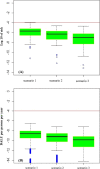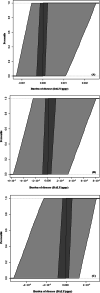Quantitative microbial risk assessment of enteroviruses in raw-eatable vegetables irrigated by wastewater: examining different scenarios of washing
- PMID: 36406612
- PMCID: PMC9672215
- DOI: 10.1007/s40201-022-00789-z
Quantitative microbial risk assessment of enteroviruses in raw-eatable vegetables irrigated by wastewater: examining different scenarios of washing
Abstract
Due to the increasing water crisis, the reuse of wastewater deserves attention as a method to reduce the pressure of the water crisis, especially in developing countries. The application of health risk assessment models is a way to estimate disease burdens associated with crop irrigation by wastewater effluents. In this study, a quantitative microbial risk assessment (QMRA) with probabilistic Monte-Carlo simulation was used to estimate the annual risk of enteroviruses (EVs) infection and disease burden for consumers of effluent-irrigated raw vegetables in Tehran, the capital of Iran. Wastewater effluent samples were collected over two seasons: summer and winter. EVs were analyzed in three stages, concentration and separation, cell culture, and real-time PCR (RT-PCR). A questionnaire was used to determine the dominant patterns of vegetable washing by consumers. There were 4 vegetable washing steps: wiping away mud (A), rinsing (B), using detergents (C), using disinfectants (D). 5 patterns of washing were examined in the laboratory and the concentration of enteroviruses was measured in every pattern. pattern 1: just wiping away mud (A), pattern 2: wiping away mud and rinsing (AB), pattern 3: wiping away mud by using detergents and rinsing (ABCB), pattern 4: wiping away mud by using disinfectants and rinsing (ABDB), and pattern 5: wiping away mud by using detergents and disinfectants and rinsing (ABCBDB). For washing pattern 1, pattern 2, and pattern 3, the estimated annual infection risk of EVs was estimated to be 5.6 × 10-1, 3.6 × 10-1, 1.7 × 10-1 (risk/per.day), and burden of disease was calculated as 3 × 10-2, 2 × 10-2, and 9 × 10-3 (burden/year), respectively. The results showed that if vegetables are washed according to method 5, the microbial risk will be minimized and the excess prevalence of viral infections will be eliminated.
Keywords: Enterovirus infection; QMRA; Real-time PCR; Vegetables; Wastewater effluents.
© The Author(s), under exclusive licence to Tehran University of Medical Sciences 2022.
Conflict of interest statement
Competing interestsThe authors declare that they have no competing interests.
Figures








Similar articles
-
Estimation of health risks caused by exposure to enteroviruses from agricultural application of wastewater effluents.Water Res. 2017 Nov 15;125:104-113. doi: 10.1016/j.watres.2017.08.028. Epub 2017 Aug 12. Water Res. 2017. PMID: 28841422
-
Quantification of human adenovirus in irrigation water-soil-crop continuum: are consumers of wastewater-irrigated vegetables at risk?Environ Sci Pollut Res Int. 2022 Aug;29(36):54561-54570. doi: 10.1007/s11356-022-19588-y. Epub 2022 Mar 18. Environ Sci Pollut Res Int. 2022. PMID: 35304720
-
Health risk attributed to consumption of vegetables irrigated with different effluents containing enteric viruses via QMRA and DALY.Sci Rep. 2025 May 26;15(1):18370. doi: 10.1038/s41598-025-00396-6. Sci Rep. 2025. PMID: 40419555 Free PMC article.
-
Campylobacter risk for the consumers of wastewater-irrigated vegetables based on field experiments.Chemosphere. 2020 Jul;251:126408. doi: 10.1016/j.chemosphere.2020.126408. Epub 2020 Mar 3. Chemosphere. 2020. PMID: 32171131
-
[Health risks from crop irrigation with treated wastewater containing antibiotic residues, resistance genes, and resistant microorganisms].Bundesgesundheitsblatt Gesundheitsforschung Gesundheitsschutz. 2023 Jun;66(6):660-668. doi: 10.1007/s00103-023-03710-7. Epub 2023 May 26. Bundesgesundheitsblatt Gesundheitsforschung Gesundheitsschutz. 2023. PMID: 37233812 Free PMC article. Review. German.
Cited by
-
Nicotine Degradation by Trametes versicolor: Insights from Diverse Environmental Stressors and Wastewater Medium.Molecules. 2025 Jun 19;30(12):2658. doi: 10.3390/molecules30122658. Molecules. 2025. PMID: 40572621 Free PMC article.
References
-
- L. Chacón, K. Barrantes, C. Santamaría-Ulloa, M. Solano, L. Reyes, L. Taylor, et al., "A somatic coliphage threshold approach to improve the management of activated sludge wastewater treatment plant effluents in resource-limited regions," Applied and Environmental Microbiology, vol. 86, 2020. - PMC - PubMed
-
- J. Fito and S. W. Van Hulle, "Wastewater reclamation and reuse potentials in agriculture: towards environmental sustainability," Environment, Development and Sustainability, pp. 1–24, 2020.
LinkOut - more resources
Full Text Sources

